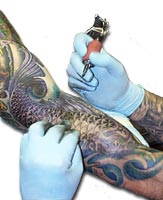 纹身是时下年青人凸现性格、展示自己、美化自己的一种方式。事实上,这股潮流已经流行了几千年。从古代埃及人、古代欧洲人、非洲部落和印第安人等等都有纹身的传统。那人们纹身是为了什么呢?下面这篇文章将为您解释一下。
纹身是时下年青人凸现性格、展示自己、美化自己的一种方式。事实上,这股潮流已经流行了几千年。从古代埃及人、古代欧洲人、非洲部落和印第安人等等都有纹身的传统。那人们纹身是为了什么呢?下面这篇文章将为您解释一下。
Whether they are on arms, legs, ankles or buttocks, tattoos are painted all over our bodies by injecting ink into our skin.
A needle attached to a hand-held tool injects ink into the cells of the dermis---a section of our skin that keeps tattoos from fading and stretching. The tool moves the needle up and down at a rate of several hundred vibrations per minute and penetrates the skin by about one millimeter. The ink that is left in the skin after the injection process is the tattoo.
Decorating our bodies with tattoos is a popular fad among many people.
The word tattoo originates from the Tahitian word tattau, which means "to mark" and was first mentioned in explorer James Cook's records from his 1769 expedition to the South Pacific. However, some scientists believe that the earliest known evidence of tattooing dates back to markings found on the skin of the Iceman, a mummified human body that dates as far back as 3300 B.C.
More widely recognized are tattoos found on Egyptian and Nubian mummies dating from about 2000 B.C. Classical authors mention the use of tattoos in connection with Greeks, ancient Germans, Gauls, Thracians and ancient Britons.
Tattooing was rediscovered by Europeans when they came into contact with Polynesians and American Indians through their explorations. Because tattoos were considered so exotic in European and U.S. societies, tattooed Indians and Polynesians amazed crowds at circuses and fairs during the 18th and 19th centuries.
The practice of tattooing has different meanings to various cultures. Decoration was the most common motive for tattooing and that still holds true today.
In some cultures, tattoos served as identification of the wearer's rank or status within a group. For instance, the early Romans tattooed slaves and criminals. Tahitian tattoos served as rites of passage, telling the history of the wearer's life.
dermis: 真皮
(来源:coolquiz.com 英语点津 Annabel 编辑)